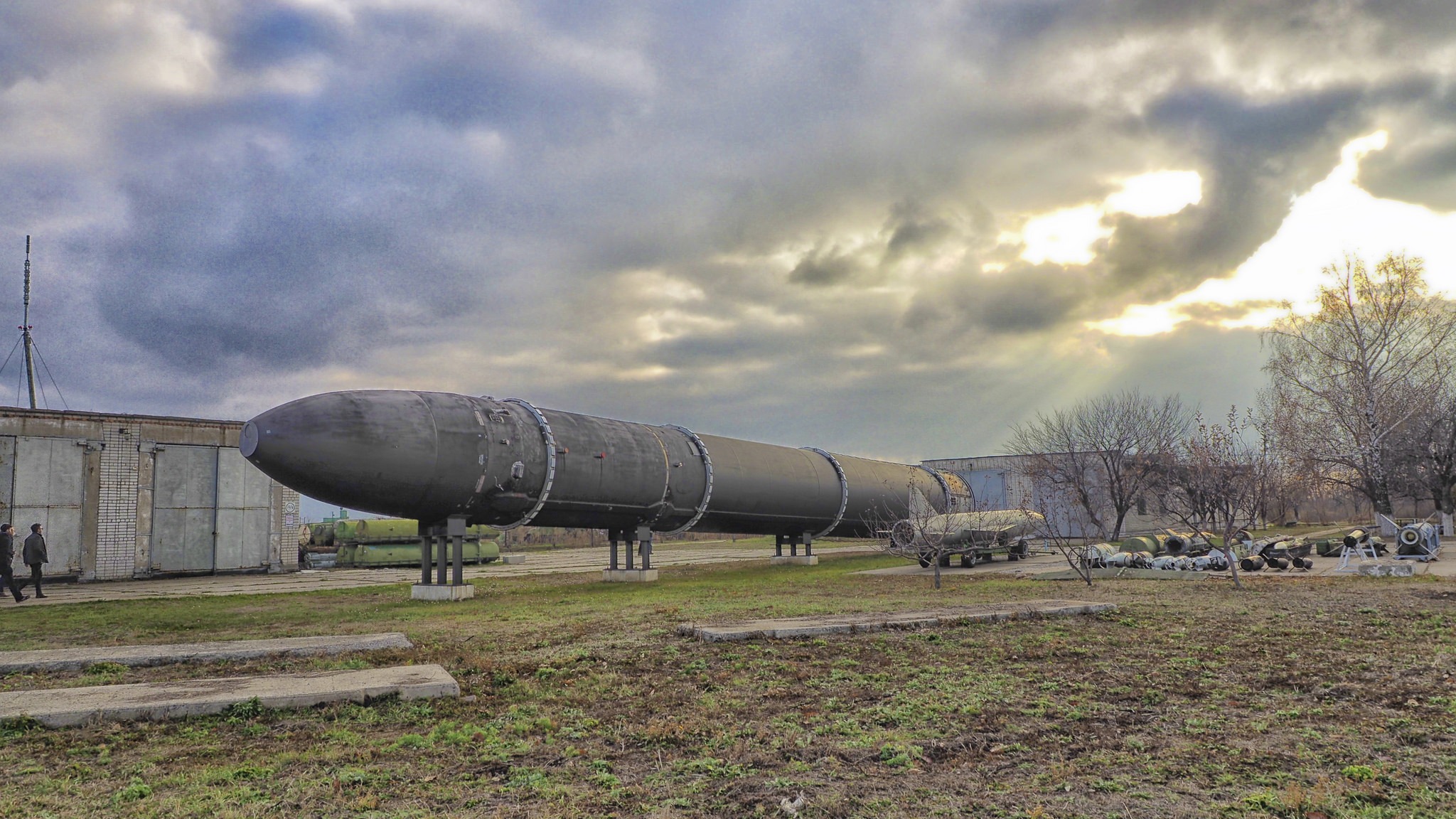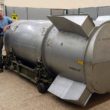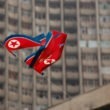Nuclear weapons are back in vogue, including the idea that gearing up to fight a nuclear war might be a wonderfully stabilizing prospect.
Ah, the fond memories: the 1983 TV movie The Day After, the nuclear freeze campaign, the B-1 bomber debate, the M-X missile fight.
You don’t remember these seminal events and debates? In a national security era dominated by fear of terrorism, a substantial part of the American population has either forgotten, or for a third (born after 1989) never knew that national security arguments in the United States from the 1950s to 1989 were dominated by the fear that there might be a nuclear war, by arguments over nuclear weapons and doctrine, and by debates over the urgent need for (or the stupidity of) arms control agreements that would constrain the nuclear arms race between the United States and the Soviet Union.
The Bulletin of the Atomic Scientists, a journal created by many of the brains that had brought the world nuclear weapons to begin with, indexed the proximity of nuclear war every year by setting its “doomsday clock”—so many minutes to midnight. The clock continues to tick to this day; right now it is two-and-a-half minutes to midnight.
The end of the Cold War pushed nuclear issues into the background for more than 25 years, clouding over our eyes, yet the weapons, even in reduced numbers, remained. Oh, there were some pretty major nuclear side-shows—Saddam Hussein, we were told, had a nuclear capability (he didn’t). Iran was rushing toward such a capability and would never stop (they did). But the big one, the fear of a U.S.-Russia nuclear Armageddon had receded into the past.
Just when you thought it was safe to go out, the whole nuclear dilemma has tumbled back onto the table. Once again, we are thinking the unthinkable. The Russians are said to be “aggressively” expanding their strategic and theater nuclear arsenal, while the Americans start a trillion-dollar nuclear modernization program of their own.
The Chinese, not to be outdone, expand and modernize their own strategic weapons, and North Korea announces it will test a strategic missile capable of striking the United States. India, whose nuclear test led to the creation of Nuclear Suppliers Group to prevent the spread of nuclear technologies, and which has not signed the Non-Proliferation Treaty, now wants to join that group, despite the semi-pariah status of its nuclear program. Only the Iranians seem to have gotten the memo that controlling nuclear arms might be a good idea, and, even then, half the world suspects they will cheat on the 2015 Joint Comprehensive Plan of Action, while Donald Trump has said his “No. 1 priority is to dismantle this disastrous deal.”
Today’s sons of Khan (not Genghis but Herman, the American theorist who considered nuclear war winnable) rattle their nuclear capabilities.
Russia’s Vladimir Putin declares “it’s best not to mess with us,” adding “I want to remind you that Russia is one of the leading nuclear powers.”
Not missing a beat, Donald Trump responds in kind: “The U.S. must greatly strengthen and expand its nuclear capability until such time as the world comes to its senses regarding nukes,” and follows up with a promise made on MSNBC: “Let it be an arms race. We will outmatch them at every pass and outlast them all.”
Former Secretary of Defense Bill Perry has warned that, “today, the danger of some sort of a nuclear catastrophe is greater than it was during the Cold War.”
Supporters of the trillion-dollar U.S. nuclear modernization program, to be found in the Pentagon, the Energy Department’s National Nuclear Security Administration (NNSA), and among the nuclear “priesthood” in Los Alamos, Lawrence Livermore, Sandia labs, and the nuclear weapons production complex are, no doubt, delighted at this turn of events. Not only is arms control being cast into the dustbin of history, a long-buried theory about nuclear deterrence and nuclear war has emerged from its grave and is once again waving its skeletal hands in front of us. That doctrine asserts that nuclear deterrence is enhanced when the United States possesses the capability of fighting a nuclear war at every level—from the battlefield to a strategic exchange.
As one defender of this renewed nuclear arms race, Matthew Kroenig, put it recently in Politico Magazine, “the United States and NATO need more flexible nuclear options in Europe. In the event of a losing war with NATO, Russian strategy calls for limited nuclear ‘de-escalation’ strikes against European civilian and military targets. At present, NATO lacks an adequate response to this threat. As I explain in a new report [for the Atlantic Council], the United States must develop enhanced nuclear capabilities, including a tactical, air-to-surface cruise missile, in order to disabuse Putin of the notion that he can use nuclear weapons in Europe and get away with it.”
The 1987 Intermediate Nuclear Forces agreement, which limited tactical nuclear weapons in Europe, has been teetering on the brink of extinction for some years, thanks to apparent Russian violations. It is about to fall into oblivion as both sides revive the doctrine that deterrence is only stable if they possess the full capability of nuclear war-fighting. It’s the mutually assured destruction, or MAD, doctrine all over again.
It’s no wonder that former Secretary of Defense Bill Perry has warned that, “today, the danger of some sort of a nuclear catastrophe is greater than it was during the Cold War and most people are blissfully unaware of this danger.” In quoting Perry’s words, Kroenig dishonestly implies that Perry supports the U.S. nuclear modernization program underway.
Perry does not. Quite the contrary; he has argued for nearly two years now that proceeding with the U.S. nuclear cruise missile program (to somehow “match” the tactical-level Russian cruise missile program), is “Cold War thinking, and it is dangerous. Such ‘tactical’ use of nuclear weapons would be a grave mistake.” Perry also supports phasing out U.S. land-based intercontinental ballistic missiles (ICBMs), though he would make the new B-21 bomber nuclear capable and develop and deploy the next generation ballistic-missile submarine program.
Supporters of a strategic nuclear buildup, especially one that would “expand” the U.S. nuclear arsenal, to use Trump’s term, have forgotten the historical debate, which led to arms control in the first place. Competing with the Russians (or anyone else) in the number of nuclear warheads and strategic vehicles is not the problem. The issue has always been how much nuclear capability is enough to deter. And that question has been pretty definitively answered—the capacity of the United States to deter a nuclear threat—survivable strategic weapons that could unleash devastation on the adversary—is probably assured at far less than 1,550 deployed strategic warheads, regardless of what deployed strategic or tactical nuclear force level the Russians maintain, according to the Defense Department’s 2013 Nuclear Employment Strategy report.
In other words, pretty much what the U.S. has today, consistent with the New START agreement signed between the United States and Russia, that entered into force five years ago. This is the profound logic that led Republican and Democratic administrations since Eisenhower to seek to limit the endless expansion of strategic weaponry. SALT, START, New START, are all governed by this thinking.
The planned modernization of U.S. ICBMs, bombers, and ballistic missile submarines would not alter that warhead level. It is also not clear that the Russian modernization programs would void that agreement. But even if the Russians did, more U.S. (or Russian) warheads and delivery vehicles, including a tactical force, would not increase the level of deterrence. They would simply cost a lot and, potentially, add to instability. Enough is enough, in the unthinkable world of nuclear weapons. Putin, spend your heart out on ICBMs and submarines, new bombers and cruise missiles—you are deterred.
It’s the theater nukes that create an immediate risk of nuclear use. These programs do not enhance deterrence; rather they lead directly to the unthinkable idea, already nurtured by Russian comments, that a nuclear exchange could happen in an unstable European theater. Talk about a return to the Cold War! It’s not surprising that imagining this level of nuclear exchange does not come from the Europeans themselves, whose countries would provide the rubble to be bounced in such a war.
Imagining a theater nuclear war in Europe is not about the weapons. It is the direct stepchild of political insecurity. Insecurity fed by assertive Russian military deployments, flights, and maneuvers, including in Ukraine. And, it must be acknowledged, insecurity amplified by U.S. and NATO policy that sped the absorption into NATO of the former Warsaw Pact countries, expanded missile defense installations to Poland, U.S. plans to modernize the roughly 200 U.S. tactical nuclear warheads in Europe and their infrastructure (e.g., the F-35 as a dual-capable aircraft) in Europe (rather than scrap them), and a well-intentioned, but misguided U.S. intrusion into the domestic political system of Russia after the Soviet Union disintegrated. There are indications that Russian perceptions of conventional military inferiority to NATO forces also plays a role in thinking among the Russian general staff that a limited, theater nuclear threat could be an important element in deterring NATO military force.
Talk about history repeating itself, this time as farce. During the Cold War, every U.S. and NATO move provoked a Soviet military development in response. And every Soviet military development provided a justification for a NATO or U.S. military development. If you want the U.S. side of that history, feast on nearly a decade of near-cartoon books produced in the 1980s about Soviet Military Power. Back then, we called this a “mirror imaging phenomenon.” Exaggerate the other side’s actions; justify your own. Do what they do; not what you need. Over time, both sides realized that spending and building at this pace was providing little or no increment of security, though it was making politicians, the military services, and the defense industry happy.
It’s not that the United States does not have enough nuclear weapons; we have more than enough. With nearly1,550 deployed strategic warheads allowed by the 2010 New START agreement through 2020, and another 3,500 in storage, the U.S. has plenty.
We can argue over warhead upgrades, how many future subs, nuclearizing the long-range bombers (I opt for eight subs, retired ICBMs, and denuclearizing the bombers; others disagree). But whatever an “expanded nuclear arsenal” may mean to Donald Trump, it would not enhance security. Mixing in magical thinking about limited nuclear war in Europe is nothing short of stupid, on both sides of the new “Iron Curtain.”
The answer to the nuclear dilemma is political, not military. It involves reassurance on both sides about intentions and capabilities; renewed negotiations to limit the expansion of nuclear programs; and a recognition that stability is in the interests of both Russia and the United States. I hold out no fond hopes that such logic will prevail over the next four years, but one never knows; given the unpredictable character of the new resident of the White House and the Russian leader’s political savvy, lightning could strike.
Gordon Adams is a Distinguished Fellow at the Stimson Center. From 1983-1987, he was the senior White House official for national security.
CORRECTION: This article has been updated to reflect that The Day After aired in 1983, not 1984, and it’s Matthew Kroenig, not Michael.







0 Comments